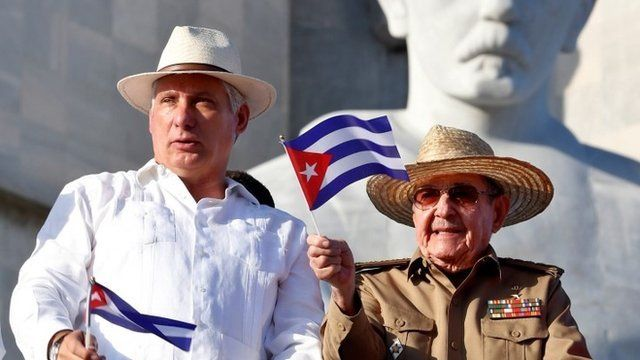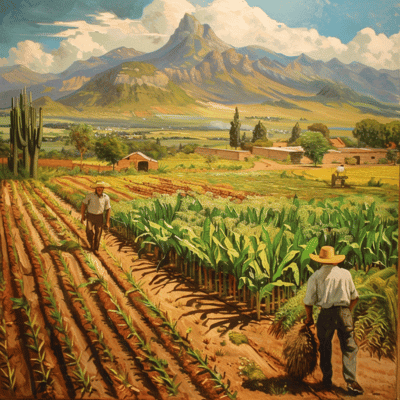Diego Rivera (Spanish pronunciation: [ˈdjeɣo riˈβeɾa]; December 8, 1886 – November 24, 1957) was a prominent Mexican painter. His large frescoes helped establish the mural movement in Mexican and international art.
Rivera had four wives and numerous children, including at least one illegitimate daughter. His first child and only son died at the age of two. His third wife was fellow Mexican artist Frida Kahlo, with whom he had a volatile relationship that continued until her death. Leon Trotsky lived with Rivera and Kahlo for several months while exiled in Mexico.
Due to his importance in the country's art history, the government of Mexico declared Rivera's works as monumentos históricos. As of 2018, Rivera holds the record for highest price at auction for a work by a Latin American artist. The 1931 painting The Rivals, part of the record-setting Collection of Peggy Rockefeller and David Rockefeller, sold for US$9.76 million.
Biography
He was born in the city of Guanajuato, Guanajuato, on December 8, 1886. At the age of eleven, he entered the National School of Fine Arts, San Carlos, where he was a student of Andrés Ríos, Santiago Rebull, José María Velasco, Leandro Izaguirre and Félix Parra. In 1902, he left the School of Fine Arts and moved to the countryside, where he dedicated himself to painting landscapes with absolute freedom, as well as to the study of pre-Columbian history and Mexican archaeology with Félix Parra. He also became friends with the engraver José Guadalupe Posada.
He was one of the most renowned visual artists and intellectuals of the early 20th century. He belonged to the group of Mexican muralists, mainly formed by José Clemente Orozco and David Alfaro Siqueiros. He cultivated painting, drawing, engraving and sculpture; he also had an enormous interest in architecture and was one of the first collectors of pre-Hispanic art.
In 1907 he presented his first exhibition at the San Carlos Academy, which won him a scholarship to study in Europe. In Madrid, he worked with Eduardo Chicharro at the Academia de San Fernando and became acquainted with Ramón del Valle-Inclán and Ramón Gómez de la Serna. In Paris he studied the works exhibited in museums, became acquainted with the modern painting of Paul Cézanne, Henri Rousseau and Pablo Picasso, and worked in the open-air schools of Montparnasse and on the banks of the Seine River. He returned to Mexico in October 1910 and participated in the events of the centennial anniversary of the independence, organized by Porfirio Diaz
In July 1912 he returned to Europe, where he dabbled in cubism, was a disciple of Pablo Picasso and exhibited works in various group exhibitions. In 1920, he traveled through Italy for seventeen months to study Etruscan, Byzantine and Renaissance art. Attracted by the political and social changes that had occurred in recent years, such as the death of Venustiano Carranza, the new government of Alvaro Obregón, as well as the possibility of working and growing in his country, he returned to Mexico in 1921.
In 1922 he began his muralist period with the decoration of the Simón Bolívar Amphitheater of the National Preparatory School. Together with José Clemente Orozco, David Alfaro Siqueiros, Xavier Guerrero, Carlos Mérida, Ramón de Alba and Fermín Revueltas, among others, he formed the Union of Technical Workers, Painters and Sculptors. From 1923 to 1926 he painted one hundred and sixty-three frescoes on the walls of the Secretaría de Educación Pública and the Escuela Nacional de Agricultura de Chapingo. Between 1927 and 1928 he was invited to the USSR by the Soviet Government and taught Monumental Painting at the School of Plastic Arts in Moscow.
Again in Mexico, in 1929, he painted murals in the Palacio de Cortés in Cuernavaca, the work known as Historia de Morelos, Conquista y Revolución; in the monumental stairway of the Palacio Nacional, Epopeya del pueblo mexicano (completed in 1935); the fresco in the Palacio de Bellas Artes, El hombre controlador del universo (1934); the panels for the Hotel Reforma in Mexico City, México folklórico y turístico, La dictadura, Danza de los huichilobos and Agustín Lorenzo (Carnaval de Huejotzingo) (1936), now in the Museo del Palacio de Bellas Artes; the frescoes of the National Institute of Cardiology (1944); Sueño de una tarde dominical en la Alameda Central (1947-1948), originally for the dining room of the Hotel del Prado; and in the Cárcamo de Dolores, El agua, origen de la vida (1951). In his later years, he painted the façade of the Estadio Olímpico Universitario, La Universidad, la familia y el deporte en México, and the façade of the Teatro de los Insurgentes, to mention a few.
In the United States, he painted frescoes on the walls of the staircase of the Luncheon Club, of the San Francisco Stock Exchange; at the School of Fine Arts, in San Francisco, California, and in the house of Mrs. Rosalind Sterns, in the same city. In New York, in the Rockefeller Center, in the Radio City Music Hall building (destroyed fresco that he later repeated in the Palace of Fine Arts in Mexico); in the New Worker's School and the frescoes in the Detroit Institute of Fine Arts.
He died in Mexico City on November 24, 1957.
Megathreads and spaces to hang out:
- 📀 Come listen to music and Watch movies with your fellow Hexbears nerd, in Cy.tube
- 🔥 Read and talk about a current topics in the News Megathread
- ⚔ Come talk in the New Weekly PoC thread
- ✨ Talk with fellow Trans comrades in the New Weekly Trans thread
- 👊 Share your gains and goals with your comrades in the New Weekly Improvement thread
- 🧡 Disabled comm megathread
reminders:
- 💚 You nerds can join specific comms to see posts about all sorts of topics
- 💙 Hexbear’s algorithm prioritizes comments over upbears
- 💜 Sorting by new you nerd
- 🌈 If you ever want to make your own megathread, you can reserve a spot here nerd
- 🐶 Join the unofficial Hexbear-adjacent Mastodon instance toots.matapacos.dog
Links To Resources (Aid and Theory):
Aid:
Theory:












